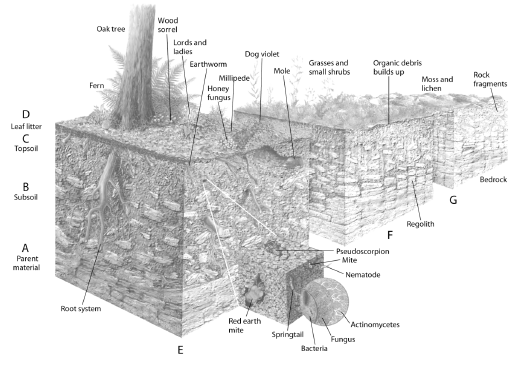Related Flashcards
Related Topics
Cards In This Set
| Front | Back |
|
The subalpine life zone in Colorado:
A. occurs above 11,400 feet in elevation B. above the grasslands life zone C. contains a greater number of species than the foothills life zone D. has greater precipitation than the foothills life zone E. b & d |
E. b & d
above the grasslands life zone has greater precipitation than the foothills life zone |
|
Deciduous plants are more likely found in:
A. Desert B. Tropical rainforest C. Grassland D. Temperate Forest E. Boreal Forest |
D. Temperate Forest
|
|
Ecology is the study of how:
A. atoms make up the environment. B. humans affect the environment. C. organisms interact with each other and their nonliving environment. D. societies pass laws to protect the environment. E. evolution affects nature |
C. organisms interact with each other and their nonliving environment.
|
|
What is the correct sequence of these ecological areas from largest to smallest?
Ecosystem, Population, Biome, Landscape, Community A. Ecosystem, Biome, Community, Landscape, Population B. Biome, Ecosystem, Landscape, Population, Community C. Biome, Landscape, Ecosystem, Community, Population D. Biome, Ecosystem, Community, Landscape, Population E. C & D |
E. C & D
Biome, Landscape, Ecosystem, Community, Population Biome, Ecosystem, Community, Landscape, Population |
|
Precipitation and temperature are generally the limiting factor that controls the vegetative character of:
A. Biomes B. Ecosystem. C. Habitat D. A, B & C E. A & B |
D. A, B & C
Biomes Ecosystems Habitat |
 Image The soil horizon that contains mineral soil and little organic matter is: A. A. B. B. C. C. D. D. E. O. |
B
|
|
The process of desertification is increased by:
A. poor agricultural practices B. overgrazing C. economic conditions D. A & B E. all of the above |
All of the above
poor agricultural practices overgrazing economic conditions |
|
Carrying capacity
A. measures stream flow and the ability to move sediment B. how much air pollution the atmosphere in Denver can carry before acid rain begins to drop C. how many individuals an ecosystem can contain without negatively impacting the environment D. how many individuals an ecosystem can contain during a time of environmental stress E. how many deer can survive in the city of Boulder eating neighborhood gardens and flowers. |
C. how many individuals an ecosystem can contain without negatively impacting the environment
|
|
Exponential growth graphically represents:
A. rapidly increasing populations B. carrying capacity C. populations approaching sustainability D. A & B E. all of the above |
A. rapidly increasing populations
|
|
Tragedy of the commons refers to:
A. common resources are used up the fastest B. rare resources are used up the fastest C. common resources are abused because they occur everywhere D. rare resources are more expensive E. B & C. |
C. common resources are abused because they occur everywhere
|
|
El Nino can effect weather in Colorado because
A. it reverses current flow in the South Pacific B. it reverses current flow in the Gulf of Mexico C. changes the pattern of weather in India D. results from unusual rainy conditions in Australia E. A & E |
A. it reverses current flow in the South Pacific
|
|
Ecosystems function through the interaction of:
A. Producers, consumers and abiotic elements B. Nutrients, water and erosion C. Nutrients, sunlight and animals D. Producers, consumers and biotic elements E. Animals, plants and populations |
A. Producers, consumers and abiotic elements
|
|
Alpine Tundra versus Arctic Tundra
A. has abundant available moisture B. has deep permafrost C. has shallow soils D. has limited daylight in winter E. B and D |
C. has shallow soils
|
|
The most permeable soil will be:
A. Clay B. Loam C. Sand D. Dust E. a mix of sand with loam |
C. Sand
|
|
The majority of deserts in the world occur:
A. near the tropic of Cancer B along the equator C. in the southern hemisphere D. near the tropic of Capricorn E. in the polar regions |
A. near the tropic of Cancer
|




